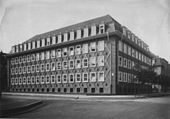Funkhaus Springerstrasse
The Funkhaus Springerstraße is a building in the north of Leipzig that was used for radio for over 50 years . It was then converted into a residential complex.
Location and building description
The building is located at the intersection of Springerstraße / Richterstraße in the Leipzig district of Zentrum-Nord. The main entrance is at Springerstraße 24. The floor plan of the house is U-shaped, with the elongated lower part of the U with 17 window axes running along Richterstraße.
The building has three floors. A mansard roof with one of the row of flat roof dormers rises above a protruding eaves edge . The attic floor has large skylights. The windows on the first three floors have only horizontal partitions.
The characteristic of the house is the facade with the diamond pattern made of brick. In the diamonds there are anthracite-colored stone crosses on a greenish-gray rough plaster. The Dehio calls this type of design "late expressionist", others speak of Art Deco . The building is a listed building.
history
The house was built in 1929/1930 according to plans by the Leipzig architect Emil Franz Hänsel (1870–1943) as an office building for the insurance company Barmenia . After the Second World War , the Barmenia insurance company was expropriated by the Soviet Military Administration (SMAD) and the undestroyed building on Springerstrasse was intended as the headquarters of a radio station, as the facilities in Barthels Hof until 1943 had been destroyed.
In 1946, the Mitteldeutscher Rundfunk began operating on Springerstrasse. At the same time, construction began on a broadcasting hall in the courtyard of the building complex, which was inaugurated in September 1947. It was the first social building in the Soviet occupation zone after the war and at the same time the first new radio building in post-war Germany. The architect was Gero Schilde, the son-in-law of Emil Franz Hänsel. Inside the building, too, conversions were necessary at the transition from the office building to the broadcasting house. The originally free-standing leg of the office building on Springerstraße was connected to the neighboring residential building (No. 22), now without a diamond pattern, and expanded to become the main entrance of the transmitter.
In this second era of independent Central German broadcasting, the traditional Leipzig radio play production with original broadcasts such as Der brave Soldat Schwejk by Jaroslav Hašek , directed by Carl Nagel, with Karl Hellmer , Wolf Kaiser , Maximilian Larsen , June 7, 1950, or Listen, here Jesus speaks Hackenberger by Walter Karl Schweikert , composition: Curt Beilschmidt, director: Werner Wieland , with Willy A. Kleinau , Robert Aßmann, July 13, 1951, set program accents that were well known throughout Germany. The formative employees in the literature department included Heinz Rusch , Hildegard Maria Rauchfuß and Georg Maurer , in the radio play department Gerhard W. Menzel and Gerhard Rentzsch . The writer Ruth Kraft was the longstanding author of the children's program .
In 1952, broadcasting in the GDR was concentrated in Berlin, and the Funkhaus in Springerstrasse lost its importance. The radio orchestras, radio choirs and most of the radio play production remained the Leipzig trademarks. The formative personalities of the sound body sector include Hermann Abendroth , Herbert Kegel , Wolf-Dieter Hauschild , Max Pommer , Jörg-Peter Weigle , Gert Frischmuth , Kurt Henkels , Rolf Kühn , Gerhard Kneifel , Fips Fleischer , Walter Eichenberg , Eberhard Weise and Hans Sandy - Günter Bormann , Martin Flörchinger , Walter Niklaus , Werner Wieland , Hans Robert Wille and Klaus Zippel were artistically productive as directors and speakers in the radio play, feature and reading production.
Since the October days of 1989 and especially with the start of broadcasting of Sachsen Radio in July 1990, the house experienced a broad activation, which formed the basis for the re-establishment of the Mitteldeutscher Rundfunk, whose central radio programs were broadcast from here on January 1, 1992 went: MDR Kultur , MDR info and MDR Life .
The interstate broadcasting agreement of the three-country establishment (Free State of Saxony, Free State of Thuringia and Saxony-Anhalt) obliged the MDR to move 25% of its central program capacities to the state of Saxony-Anhalt. Thuringia received the MDR's Werbe subsidiary GmbH as a location equivalent.
Although Leipzig had a great tradition to defend in German radio history as the second radio station after Berlin, the management of the MDR at the time decided to relocate the central radio programs for this compensation service, and so the radio of the MDR had to move to Halle in 1999 (Saale) move into a building leased by MDR. MDR symphony orchestras and radio choirs were given a new domicile on Leipzig's Augustusplatz next to the New Gewandhaus.
After a few years of vacancy, an investor decided in 2008 to convert the Springerstraße building into a residential building with around forty owner-occupied and rental apartments. The broadcasting hall was demolished and an underground car park with a children's playground was built on its roof in its place. For two new stairwells, the facade in Richterstrasse had to be interrupted by two access doors.
literature
- Hansdieter Hoyer: The diamond pattern has remained. Living in the old radio house in Springerstrasse , Leipziger Blätter No. 57 (2010), ISSN 0232-7244 , pp. 53-55
Web links
- The Funkhaus in Leipziger Springerstraße , near MDR Figaro ( Memento from March 10, 2014 in the Internet Archive )
- The Funkhaus Springerstraße through the ages , picture gallery
Individual evidence
- ↑ Leipziger Blätter No. 57 p. 53
- ↑ List of cultural monuments in Leipzig-Zentrum-Nord
Coordinates: 51 ° 21 ′ 19 ″ N , 12 ° 22 ′ 25 ″ E



